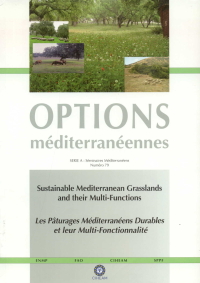| Article précédent | p. 123-126 | Article suivant |
Carbon sequestration in biodiverse sown grasslands
Sown biodiverse rainfed permanent grasslands are based on diverse mixtures of about twenty different species, and rich in legumes. These grasslands were much more productive than the natural ones, thus allowing sustainable animal carrying capacity to be increased. They also highly accelerate the rate of soil organic matter (SOM) increase, which contributes to carbon sequestration. This effect led Portugal to select, within the framework of the voluntary LULUCF activities under Article 3.4 of the Kyoto Protocol, the Grassland Management activity. However, the implication of using sown grasslands is more widespread, influencing the carbon accounting in other Articles of the Protocol. In this paper we determined the CO2 sequestration potential of this type of sown grasslands. We estimated a net carbon balance of 4,5-5,3 ton CO2eq/ha/year. Considering an implementation scenario of 300,000 ha, the total sink effect would be 0.96-1.35 Mton CO2eq/year.
Les prairies permanentes biodiverses semées sont fondées sur divers mélanges d'une vingtaine d'espèces différentes, mais riches en légumineuses. Ces prairies sont beaucoup plus productives que les prairies naturelles, permettant ainsi une augmentation de la capacité de charge animale durable. Elles ont également fortement accéléré le taux d'augmentation de la matière organique du sol (SOM), ce qui contribue à la séquestration du carbone. Cet effet a conduit le Portugal à choisir, dans le cadre des activités volontaires LULUCF au titre de l'article 3,4 du Protocole de Kyoto, le Grassland Management. Cependant, l'implication de l'utilisation de prairies ensemencées est plus répandue, ce qui influe sur la comptabilisation du carbone dans d'autres articles du Protocole. Dans le présent document, nous déterminons le potentiel de séquestration du CO2 de ce type de prairies ensemencées. Nous estimons un bilan de carbone de 4,5-5,3 ton CO2eq·hectares-1·année-1. Considérant la mise en œuvre de 300.000 ha dans ce scénario, l'effet de puits total serait de 0.96-1.35 Mton CO2eq·année-1.
- [ Afficher ]
- [ Télécharger ]
- [ Exporter la citation ]
Vous pouvez télécharger la citation au format :
- [ Imprimer ]
-
Mots-clés
BIODIVERSITE, LEGUMINEUSE FOURRAGERE, MATIERE ORGANIQUE DU SOL, OXYDE DE CARBONE, PRAIRIE ARTIFICIELLE, PRAIRIE PERMANENTE, PRODUCTIVITECiter cet article
Teixeira R., Domingos T., Canaveira P., Avelar T., Basch G., Belo C., Calouro F., Crespo D., Ferreira V.G., Martins C. Carbon sequestration in biodiverse sown grasslands. In : Porqueddu C. (ed.), Tavares de Sousa M.M. (ed.). Sustainable Mediterranean grasslands and their multi-functions . Zaragoza : CIHEAM / FAO / ENMP / SPPF, 2008. p. 123-126. (Options Méditerranéennes : Série A. Séminaires Méditerranéens; n. 79). 12. Meeting of the Sub-Network on Mediterranean Forage Resources of the FAO-CIHEAM Inter-regional Cooperative Research and Development Network on Pastures and Fodder Crop, 2008/04/09-12, Elvas (Portugal). http://om.ciheam.org/om/pdf/a79/00800630.pdf



